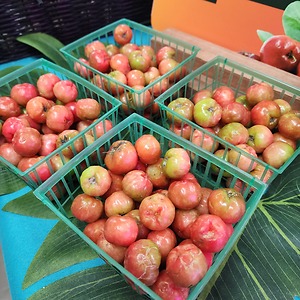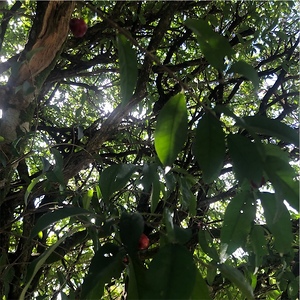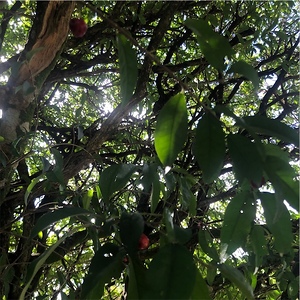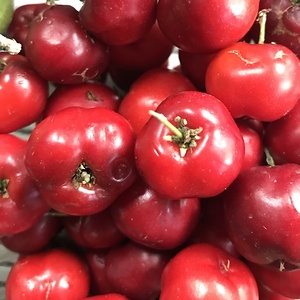

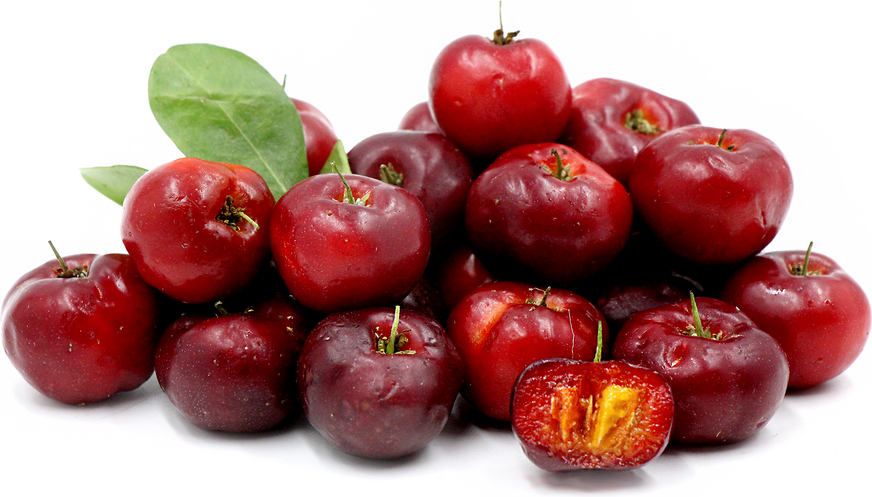
Barbados Cherries (Acerola)
Estimated Inventory, lb : 0
This item was last sold on : 04/13/24
Description/Taste
Barbados cherries are small fruits, averaging 1 to 3 centimeters in diameter, and have a round to oblate shape with broad, flat shoulders and a curved center tapering to a narrow base. The fruits resemble bulbous, slightly flattened cherries and have thin, glossy, and taut skin. The skin is easily damaged when handled, bruising easily, and ripens from green, yellow, to shades of bright and dark red when ripe. Barbados cherries will also transition from hard to slightly soft to the touch at maturity. Underneath the surface, the red-orange flesh is soft, aqueous, pulpy, and succulent. The flesh also encases 2 to 3 seeds arranged in a triangular shape in the center of the fruit. These seeds are discarded and are not consumed. Barbados cherries can be eaten raw or cooked when ripe and have a sweet-tart flavor with fruity, bright, and acidic notes.
Seasons/Availability
Barbados cherries are generally available in the summer through early winter. Each region's season will vary, depending on the climate, and some locations may have a few small crops throughout the year, while other areas may have heavier, less frequent crops.
Current Facts
Barbados cherries, botanically a part of the Mapighia genus, are tropical to subtropical fruits belonging to the Malpighiaceae family. The fruits grow individually or in groupings of 2 to 3 fruits and are found on evergreen shrubs to small trees reaching 3 to 4 meters in height. Barbados cherries are native to the Americas, and two species are associated with the fruits. Malpighia emarginata is the main species, producing large harvests, and this species was once labeled as Malpighia punicifolia. The second species, Malpighia glabra, is primarily a wild or ornamental species producing small fruit quantities. Barbados cherries are a type of drupe typically harvested approximately 22 to 25 days after flowering. Each tree can develop 62 to 82 pounds of fruit in one season, depending on the climate and region the fruits are grown in, and the fruits are hand-harvested to protect their delicate, easily bruised skin. Barbados cherries are also known as Acerola, West Indian cherry, Antilles cherry, Semeruco, Wild Crepe Myrtle, Garden Cherry, Cerisier in French, Cerejeira in Portuguese, and Acerola, Semeruco, and Cereza in Spanish. The species is mainly planted in home gardens, favored as a fast-growing, low-maintenance, and hardy plant, and is suitable for container or ground growing. In the modern day, Barbados cherries are typically consumed fresh for their sweet-tart taste or incorporated into an array of sweet and savory heated preparations.
Nutritional Value
Barbados cherries are famously known for their high vitamin C content. Research and studies conducted on the fruits have shown that consuming 2 to 3 fruits may contain the daily recommended allowance of vitamin C, a nutrient that strengthens the immune system and boosts collagen production in the body. Barbados cherries also provide calcium to build strong bones and teeth, vitamin A to maintain healthy organ functioning, iron to develop the protein hemoglobin for oxygen transport through the bloodstream, and other amounts of phosphorus, niacin, riboflavin, and B vitamins. The fruit's pigmented nature showcases the presence of anthocyanins, which are natural compounds with antioxidant-like properties to reduce inflammation and protect the cells from the damage caused by free radicals.
Applications
Barbados cherries have a sweet-tart flavor suited for fresh and cooked preparations. The fruits are popularly consumed straight out of hand when ripe and are also sliced and mixed into parfaits, oatmeal, grain bowls, salsa, and salads. When harvesting the fruits, it is recommended to wear gloves, as the leaves and stems may bear a fuzz that can irritate the skin. Once picked, the fruits should be immediately consumed as their thin skin does not hold up to excessive handling. In Barbados, the fruits are commonly eaten fresh by children in home gardens. Barbados cherries are also pressed into juices and bottled as a children's drink, valued for their high vitamin C content. In addition to fruit drinks, the juice can be added to cocktails, fermented into wine, mixed into smoothies, simmered into jams and jellies, or infused into syrups. Barbados cherries can also be blended and frozen into ice cream and popsicles or stewed with sugar to create a sauce or filling for pies, puddings, cakes, bars, and macarons. Try drizzling a Barbados cherry sauce over sliced bananas as a decadent treat. Beyond fresh uses, Barbados cherries are processed into powders and added to concentrates and supplements. Barbados cherries pair well with other fruits such as bananas, apples, berries, and citrus, vanilla, maple syrup, sugar, and chocolate. Ripe Barbados cherries should be immediately consumed for the best quality and flavor. The fresh fruits will only keep up to three days in the refrigerator. For extended storage, the fruits can be juiced and frozen.
Ethnic/Cultural Info
Barbados cherries are known as Bajan cherries in Barbados and are a beloved fruit deeply embedded into the lifeblood of the island nation. One of the most popular uses of the fruits is as a juice to fight colds. Bajan cherry juice is traditionally consumed when children and adults in Barbados are feeling under the weather, and among local folklore, the juice is thought to give the body a boost and shorten the duration of a cold. Barbados cherries are also used in natural skincare treatments throughout Barbados to brighten the skin. Famous Barbadian singer and businesswoman Rihanna notably used Barbados cherries in Fenty Skin, her global skincare line. The juice is incorporated into a body scrub, toner, serum, and cleanser to brighten and soften the skin.
Geography/History
Barbados cherries are native to the Americas, spanning a region from the Lesser Antilles islands in the Caribbean Sea to Brazil in South America. The species has been growing wild since ancient times and has become naturalized in tropical to subtropical regions throughout Central and South America. Throughout history, Barbados cherries were selected as a home garden species and were planted in containers and backyards for their ornamental nature. In the late 19 century, Barbados cherries were carried from Cuba by horticulturist Pliny Reasoner and were planted in Florida. Seeds were also introduced from Curacao and given to the United States Department of Agriculture through American forester H.M. Curran in 1917. Since their introduction into the United States, Barbados cherries have spread in cultivation to southern Texas, Florida, and California. Barbados cherry trees also saw an increase in plantings after World War II when seedlings were distributed by the United States Department of Agriculture to families to plant in their Victory Gardens. Later in 1945, studies were published about the fruit's vitamin C content, also known as ascorbic acid, through a research facility in Puerto Rico, launching the species as a medicinal aid and nutritional booster. Today Barbados cherries are primarily grown in home gardens and through small-scale growers and can be found through fresh markets in South, Central, and North America, the Caribbean, and select regions of Southeast Asia, Australia, and Africa.
Recipe Ideas
Recipes that include Barbados Cherries (Acerola). One
Podcast



